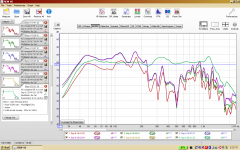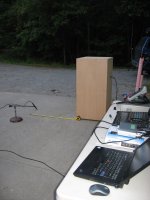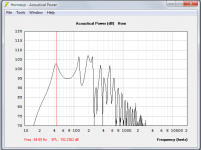1) You should be able to measure voltage on the amp output during the sweep test using a true RMS voltmeter on the AC scale, pink noise is too sporadic to get a good reading. 2 volts would be one watt in to a nominal 4 ohm load.1) Same signal - yes. Moved cabs in and out of same test position. 2volts? Across amp output? Not sure - what is correct way to measure 2v at output? Pink noise or sine at some freq?
2)BR cab is 16cuft tuned to 42.5hz. It has a bump at 50hz. Lower tuning smooths out bump but looses power handeling and gives very little lower extension.
3)AFAIK the only filter used in this A/B test was 3rd order hi cut at 100hz.
4)Mic at ground plane 4 feet in front of cab.
In answer #1 you write "cabs", in #4 "cab". How many of each type of cabinet?
2) The test results are almost flat, I don't see a 50Hz "bump".
3) Looks like you missed a filter, just can't imagine the BR and TH having an identical roll off.
4) What ever happened to the metric system 😉?
1) You should be able to measure voltage on the amp output during the sweep test using a true RMS voltmeter on the AC scale, pink noise is too sporadic to get a good reading. 2 volts would be one watt in to a nominal 4 ohm load.
In answer #1 you write "cabs", in #4 "cab". How many of each type of cabinet?
2) The test results are almost flat, I don't see a 50Hz "bump".
3) Looks like you missed a filter, just can't imagine the BR and TH having an identical roll off.
4) What ever happened to the metric system 😉?
Thank you for your patience with my measurement skills. 🙂
One BR cab - two KS cabs.
I should have wrote, "WinIsd predicted a bump at 50hz. Choosing lower tuning shows smoothed out bump but looses power handeling and gives very little lower extension." Actually, maybe I shoulda just left that out totally.
The tuning of 42.5hz is what WT3 measured on dual 18 BR cab.
I shall probe further this evening.
Gave another try with REW....
2 volts @ mid sine sweep – 25hz to 10khz. PVR1 mic, ground plane @ exactly 1 meter, on axis into M-Audio Mobile Pre USB into QSC SRA 3622. No HPF or LPF applied. 5.2 meters from any structure. All drivers are Peavey Low Rider 18s.
Red = 1 KS
Green = 1 dual 18 BR – 16 cu.ft. at 42.5hz
Purple = 2 KS
2 volts @ mid sine sweep – 25hz to 10khz. PVR1 mic, ground plane @ exactly 1 meter, on axis into M-Audio Mobile Pre USB into QSC SRA 3622. No HPF or LPF applied. 5.2 meters from any structure. All drivers are Peavey Low Rider 18s.
Red = 1 KS
Green = 1 dual 18 BR – 16 cu.ft. at 42.5hz
Purple = 2 KS
Attachments
@ tralfaz
It will give you more acurate results, when you lie the mic directly on the ground.
(see 'ground plane measurements')
Regards
Criwo
It will give you more acurate results, when you lie the mic directly on the ground.
(see 'ground plane measurements')
Regards
Criwo
Wondered that myself.
I have to ask a real noob question? The Low Riders are 8ohm. So the KS is 8ohm and I assume the BR drivers are wired parallel = 4ohm. Wouldn't the voltage need to be adjusted for this? IE- 2v for the BR and 2.83v for the KS. Even more noob and probably dumb, do you just put a meter (VAC) on the amp outputs and raise signal until meter reads proper voltage?
Seems odd there is not an FAQ or stickied thread for some basics like this so when guys like me ask noob questions you guys could just point us to it.
I have to ask a real noob question? The Low Riders are 8ohm. So the KS is 8ohm and I assume the BR drivers are wired parallel = 4ohm. Wouldn't the voltage need to be adjusted for this? IE- 2v for the BR and 2.83v for the KS. Even more noob and probably dumb, do you just put a meter (VAC) on the amp outputs and raise signal until meter reads proper voltage?
Seems odd there is not an FAQ or stickied thread for some basics like this so when guys like me ask noob questions you guys could just point us to it.
@ tralfaz
It will give you more acurate results, when you lie the mic directly on the ground.
(see 'ground plane measurements')
Regards
Criwo
I will re-check available info......I have always placed mic at roughly 45* angle to ground at < 1/16" to surface. I got his practice from posts/photos I read years ago on PSW forums from some pretty sharp folks....never thought to question it.
Wondered that myself.
I have to ask a real noob question? The Low Riders are 8ohm. So the KS is 8ohm and I assume the BR drivers are wired parallel = 4ohm. Wouldn't the voltage need to be adjusted for this? IE- 2v for the BR and 2.83v for the KS. Even more noob and probably dumb, do you just put a meter (VAC) on the amp outputs and raise signal until meter reads proper voltage?
Seems odd there is not an FAQ or stickied thread for some basics like this so when guys like me ask noob questions you guys could just point us to it.
Yes....one KS is nominal 8 ohm and my one BR is nominal 4 ohm. I guess I should adjust drive voltage to KS when I compare one KS to one BR. Thank you.
I am still confused on setting drive voltage. Have to see if my meter is RMS or not. Clearly, I am still learning. 😱
What I did yesterday was put meter across amp output and start stimulus signal. Voltage starts at 0, rises to 2 v, then falls back down. I saw that at the mid point of the sweep I had 2 volts.
Your measurements in post # 323 look much more like I expected, if you used 2.83 V (one watt at nominal 8 ohms) for the single Keystone compared to 2 V for the four ohm dual drivers, you would see pretty much the same level. As it was, the single Keystone was getting 3 dB less power than the dual BR.What I did yesterday was put meter across amp output and start stimulus signal. Voltage starts at 0, rises to 2 v, then falls back down. I saw that at the mid point of the sweep I had 2 volts.
The charts show two Keystones almost 6 dB more sensitive in the upper and lower response, with a midband "saddle" dip as was predicted for the Low Riders.
If you run a 0 Hz to upper sweep, you should see the lower response that the 25 Hz sweep is (apparently) cutting off.
Your meter is probably be most accurate at 60 Hz, the usual USA mains AC voltage. Not familiar with REW, but if you set voltage with a 60 Hz sine wave (if available), it should probably be the same voltage throughout the sweep range.
Art
If you're referring to the "saddle response" chart in post number 329, and you mean "nvm" as "not very manly", referring to a lack of BL of the LowRider compared to the recommended BNC drivers, I agree with your insight.
So.... I went into the project having a fair idea of what the performance would be – Art pretty well nailed it. However - it is still useful and louder than what I started with... plus they have a nice sound.
I used drivers that I already had on hand to a better effect and when all is done will have 4 smaller, lighter, easier to move about cabs that are a better height/width for stacking my 4 tops.
If/when I have money/desire for upgrade drivers/amps it will be an easy swap. In addition I have learned a little bit more about making audio measurements along the way.
***************************************
Moving on to actually using the Keystone (Low Rider version) in a system.....what would anyone recommend as a low cut filter? …..and a little EQ to smooth out the “saddle” ?
Also, I plan to cross them over around 100hz into the tops. I'm guessing I will still have to EQ down the prominent peak at 175hz?
I used drivers that I already had on hand to a better effect and when all is done will have 4 smaller, lighter, easier to move about cabs that are a better height/width for stacking my 4 tops.
If/when I have money/desire for upgrade drivers/amps it will be an easy swap. In addition I have learned a little bit more about making audio measurements along the way.
***************************************
Moving on to actually using the Keystone (Low Rider version) in a system.....what would anyone recommend as a low cut filter? …..and a little EQ to smooth out the “saddle” ?
Also, I plan to cross them over around 100hz into the tops. I'm guessing I will still have to EQ down the prominent peak at 175hz?
John,So.... I went into the project having a fair idea of what the performance would be – Art pretty well nailed it. However - it is still useful and louder than what I started with... plus they have a nice sound.
Moving on to actually using the Keystone (Low Rider version) in a system.....what would anyone recommend as a low cut filter? …..and a little EQ to smooth out the “saddle” ?
Also, I plan to cross them over around 100hz into the tops. I'm guessing I will still have to EQ down the prominent peak at 175hz?
I still don't think the latest graph you posted is representative of the LF response, I'd like to see a full range sweep, rather than starting at 25 Hz before advising on the low cut filter. If you don't do that, you can simply look at excursion, set the low cut filter so excursion stays under control using pink noise run up to your amp limits. Probably be around a 30 Hz 24 BW filter, BW has less cut at the knee frequency than LR. The LowRider probably will run out of excursion in the 60 Hz range before 30-35 Hz, don't overdo the low cut filter.
Apply the inverse EQ of your measured response to smooth out the "saddle" dip and upper peak. If you have two bands of PEQ on the sub output of your DSP, apply a broad band boost around 70 Hz to correct the saddle, and a narrow Q cut at 175 Hz, measure the response with HP and LP in place to see what changes are needed.
You have shown the pair of Keystones has increased small signal (2V, only 1/2 watt per speaker) response by around +5 dB over the BR in the 45 Hz and 100 Hz range, I'm still curious how the LowRiders compare at large signal level, with your amp just at limit, like we all actually run them ;^)
Doing the high power test, then turning the DSP output down by 10 dB and 20 dB will make power and port compression evident at the various levels you would use the subs.
Art
Last edited:
In broad terms, 4 KS more than doubles output of the 2 BR with same power, right? 1 KS is now 1.5db over 1 BR (via 3db gain from 2v to 2.83v). Another KS is a 6db gain. 7.5db gain? 4 KS to 2 BR
Thanks Art, for your continued input. I will test further as soon as time/weather permits.......
Zwiller,In broad terms, 4 KS more than doubles output of the 2 BR with same power, right? 1 KS is now 1.5db over 1 BR (via 3db gain from 2v to 2.83v). Another KS is a 6db gain. 7.5db gain? 4 KS to 2 BR
Tralfaz did not test 4 Keystones.
Tralfaz last test showed two LowRider Keystones had increased small signal (2V, only 1/2 watt per speaker) response by around +5 dB over the dual 18" BR in the 45 Hz and 100 Hz range, but only about +1.5dB in the 70 Hz range.
Doubling output would be +6 dB across the entire range, which occurred in my test using the B&C18SW115-4, but not with the LowRiders.
Art
I must say, that Zwillers sim of the lowrider keystone looks anything but optimal... People complain about the rising response of FLH's, this looks even more trouble. I hope the sim and your test are showing something wrong here? Art's original graphs I've seen around are nothing like yours... Whats this all about?
Last edited:
I must say, that Zwillers sim of the lowrider keystone looks anything but optimal... People complain about the rising response of FLH's, this looks even more trouble. I hope the sim and your test are showing something wrong here? Art's original graphs I've seen around are nothing like yours... Whats this all about?
Art's graphs are with as designed for B&C drivers - my "data" is with Low Rider drivers on hand ?
Zwiller,
Doubling output would be +6 dB across the entire range, which occurred in my test using the B&C18SW115-4, but not with the LowRiders.
Art
Thanks, got it.
i was commenting on the low end responce,but it was already answered.If you're referring to the "saddle response" chart in post number 329, and you mean "nvm" as "not very manly", referring to a lack of BL of the LowRider compared to the recommended BNC drivers, I agree with your insight.
i stil think there is a low pass in place or maybe the mic or something else ,it just doesn't seem right.
- Home
- Loudspeakers
- Subwoofers
- Keystone Sub Using 18, 15, & 12 Inch Speakers


